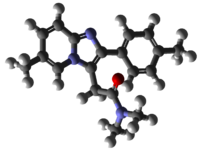唑吡坦
此條目需要擴充。 (2014年2月13日) |
唑吡坦(英語:Zolpidem)是一種Z-drugs安眠藥,約在口服三十分鐘之內起效,藥效維持兩至三小時。市場上常見的藥名包括、Adormix、Ambien、Ambien CR、Edluar、Damixan、Ivedal、Nytamel、Stilnoct、Stilnox、Sucedal、Zoldem、Zolnod及Zolpihexal等[1][2][3][4],中國大陸商品名為思諾思(英語:Stilnox),台灣則有佐沛眠(英語:Zolpium)、使蒂諾斯等名稱。
 | |
 | |
| 臨床資料 | |
|---|---|
| 懷孕分級 |
|
| 给药途径 | Oral |
| ATC碼 | |
| 法律規範狀態 | |
| 法律規範 | |
| 藥物動力學數據 | |
| 生物利用度 | 70% (oral) 92% bound in plasma |
| 药物代谢 | 肝脏:CYP3A4(~60%)、CYP2C9(~20%)、CYP1A2(~14%)、CYP2D6(<3%)、CYP2C19(<3%) |
| 生物半衰期 | 2.5至3小时 |
| 排泄途徑 | 56% 经尿液,34% 经粪便 |
| 识别信息 | |
| |
| CAS号 | 82626-48-0 |
| PubChem CID | |
| DrugBank | |
| ChemSpider | |
| CompTox Dashboard (EPA) | |
| ECHA InfoCard | 100.115.604 |
| 化学信息 | |
| 化学式 | C19H21N3O |
| 摩尔质量 | 307.40 g·mol−1 |
| 3D模型(JSmol) | |
| |

药理学
编辑唑吡坦是GABAA受体的正别构调节剂,它选择性结合GABAA受体的α1亚基,因此它具有较强的催眠和较弱的抗焦虑、肌肉松弛和抗惊厥特性。[5]与地西泮不同,唑吡坦可以与αβGABAA受体结合,它被证明与α1-α1界面结合。[6]唑吡坦对α2-和α3-亚基的亲和力比对α1低10倍,且对含α5亚基的受体没有表现出明显的亲和力。[7][8]含α1亚基的苯二氮卓位点(旧称ω1)主要存在于大脑中,而含α2亚基的苯二氮卓位点(旧称ω2)主要存在于脊柱中,因此唑吡坦更易于与位于大脑而不是脊柱中的GABAA受体结合。[9]唑吡坦对含有γ1和γ3亚基的受体没有亲和力,并且像绝大多数苯二氮卓类药物一样,它也对含有α4和α6亚基的受体缺乏亲和力。[10]唑吡坦或许是通过诱导受体构象来调节受体,它诱导的构象能够通过正调节位点调节激动剂γ-氨基丁酸与其同源受体的结合强度,而不影响脱敏或峰值电流。[11]
与扎来普隆类似, 唑吡坦可能增加慢波睡眠,但对第二睡眠期没有影响。[12]一项比较苯二氮卓类药物与非苯二氮卓类药物的文献综述显示,唑吡坦和苯二氮卓类药物在入睡潜伏期、总睡眠持续时间、觉醒次数、睡眠质量、不良事件、耐受性、失眠反弹和日间警觉性方面几乎没有显著的差异。[13]
药代动力学
编辑微粒体研究表明唑吡坦由CYP3A4(61%)、CYP2C9(22%)、CYP1A2(14%)、CYP2D6(<3%)和CYP2C19(<3%)代谢。[14]只有不到1%以原药形式从尿液排出。[5]唑吡坦的绝对生物利用度约为70%,在2小时内达到峰值浓度,在健康成年人中半衰期为2至3小时,[15][5]但在儿童中会缩短,在老年人和肝功能有问题的人群中延长。
在肝功能不全的人群中,其生物利用度增加。消除率减少和消除半衰期增长致大约十个小时。在肾功能不全的人群中,可观察到清除率中等降低。其他参数不变。唑吡坦不能通过透析清除。[16]
参考资料
编辑- ^ Ambien.com. AMBIEN Prescribing Information. Information About a Short-term Treatment for Insomnia - Ambien.com Home Page for Health-care Professionals. Sanofi-Synthelabo Inc. New York, NY 10016. 2004 [2005-06-27]. (原始内容存档于2005-06-27).
- ^ STILNOX (zolpidem tartrate) PRODUCT INFORMATION (页面存档备份,存于互联网档案馆) Sanofi-Synthelabo Australia Pty Limited. April 15, 2004
- ^ sanofi-aventis : Drugs and Products - CNS - Stilnox/Ambien/Myslee. 2006-11-07 [2006-11-22]. (原始内容存档于2007-09-27).
- ^ Benzodiazepine Names. (原始内容存档于2008-12-08).
- ^ 5.0 5.1 5.2 Salvà P, Costa J. Clinical pharmacokinetics and pharmacodynamics of zolpidem. Therapeutic implications. Clinical Pharmacokinetics. September 1995, 29 (3): 142–153. PMID 8521677. S2CID 23391285. doi:10.2165/00003088-199529030-00002.
- ^ Che Has AT, Absalom N, van Nieuwenhuijzen PS, Clarkson AN, Ahring PK, Chebib M. Zolpidem is a potent stoichiometry-selective modulator of α1β3 GABAA receptors: evidence of a novel benzodiazepine site in the α1-α1 interface. Scientific Reports. June 2016, 6: 28674. Bibcode:2016NatSR...628674C. PMC 4921915 . PMID 27346730. doi:10.1038/srep28674.
- ^ Pritchett DB, Seeburg PH. Gamma-aminobutyric acidA receptor alpha 5-subunit creates novel type II benzodiazepine receptor pharmacology. Journal of Neurochemistry. May 1990, 54 (5): 1802–4. PMID 2157817. S2CID 86674799. doi:10.1111/j.1471-4159.1990.tb01237.x.
- ^ Smith AJ, Alder L, Silk J, Adkins C, Fletcher AE, Scales T, Kerby J, Marshall G, Wafford KA, McKernan RM, Atack JR. Effect of alpha subunit on allosteric modulation of ion channel function in stably expressed human recombinant gamma-aminobutyric acid(A) receptors determined using (36)Cl ion flux. Molecular Pharmacology. May 2001, 59 (5): 1108–18. PMID 11306694. S2CID 86156878. doi:10.1124/mol.59.5.1108.
- ^ Rowlett JK, Woolverton WL. Assessment of benzodiazepine receptor heterogeneity in vivo: apparent pA2 and pKB analyses from behavioral studies. Psychopharmacology. November 1996, 128 (1): 1–16. PMID 8944400. S2CID 25654504. doi:10.1007/s002130050103. (原始内容存档于12 January 2002).
- ^ Wafford KA, Thompson SA, Thomas D, Sikela J, Wilcox AS, Whiting PJ. Functional characterization of human gamma-aminobutyric acidA receptors containing the alpha 4 subunit. Molecular Pharmacology. September 1996, 50 (3): 670–8 [7 October 2007]. PMID 8794909. (原始内容存档于8 January 2009).
- ^ Perrais D, Ropert N. Effect of zolpidem on miniature IPSCs and occupancy of postsynaptic GABAA receptors in central synapses. The Journal of Neuroscience. January 1999, 19 (2): 578–88. PMC 6782193 . PMID 9880578. doi:10.1523/JNEUROSCI.19-02-00578.1999.
- ^ Noguchi H, Kitazumi K, Mori M, Shiba T. Electroencephalographic properties of zaleplon, a non-benzodiazepine sedative/hypnotic, in rats. Journal of Pharmacological Sciences. March 2004, 94 (3): 246–51. PMID 15037809. doi:10.1254/jphs.94.246 .
WARNING: The reference indicates that zaleplon-Sonata, not zolpidem, increases Slow-wave sleep
- ^ Dündar Y, Dodd S, Strobl J, Boland A, Dickson R, Walley T. Comparative efficacy of newer hypnotic drugs for the short-term management of insomnia: a systematic review and meta-analysis. Human Psychopharmacology. July 2004, 19 (5): 305–22. PMID 15252823. S2CID 10888200. doi:10.1002/hup.594.
- ^ Von Moltke LL, Greenblatt DJ, Granda BW, Duan SX, Grassi JM, Venkatakrishnan K, et al. Zolpidem metabolism in vitro: responsible cytochromes, chemical inhibitors, and in vivo correlations. British Journal of Clinical Pharmacology. July 1999, 48 (1): 89–97. PMC 2014868 . PMID 10383565. doi:10.1046/j.1365-2125.1999.00953.x.
- ^ Zolpidem (Monograph). The American Society of Health-System Pharmacists. 27 April 2023 [10 March 2024]. (原始内容存档于2018-03-16).
- ^ 酒石酸唑吡坦说明书 (PDF). [2024-07-07]. (原始内容存档 (PDF)于2024-07-07) (中文).
外部連結
编辑- Zolpidem. Drug Information Portal. U.S. National Library of Medicine. [2020-10-22]. (原始内容存档于2020-11-27).
- Man who couldn't talk or move for 8 years 'wakes up' 20 minutes after docs gave him sleeping drug(页面存档备份,存于互联网档案馆)
| 这是一篇與医学相關的小作品。您可以通过编辑或修订扩充其内容。 |